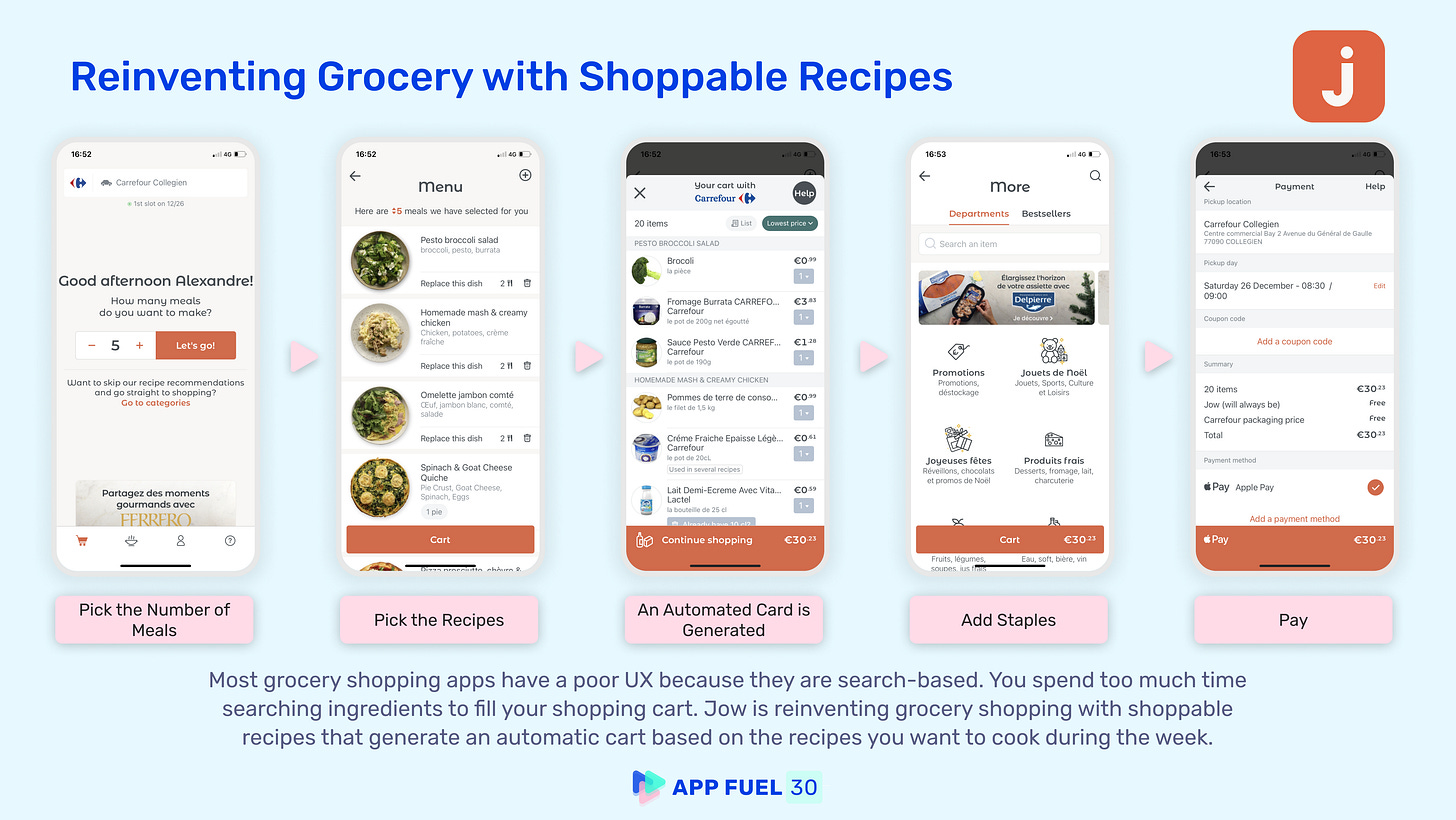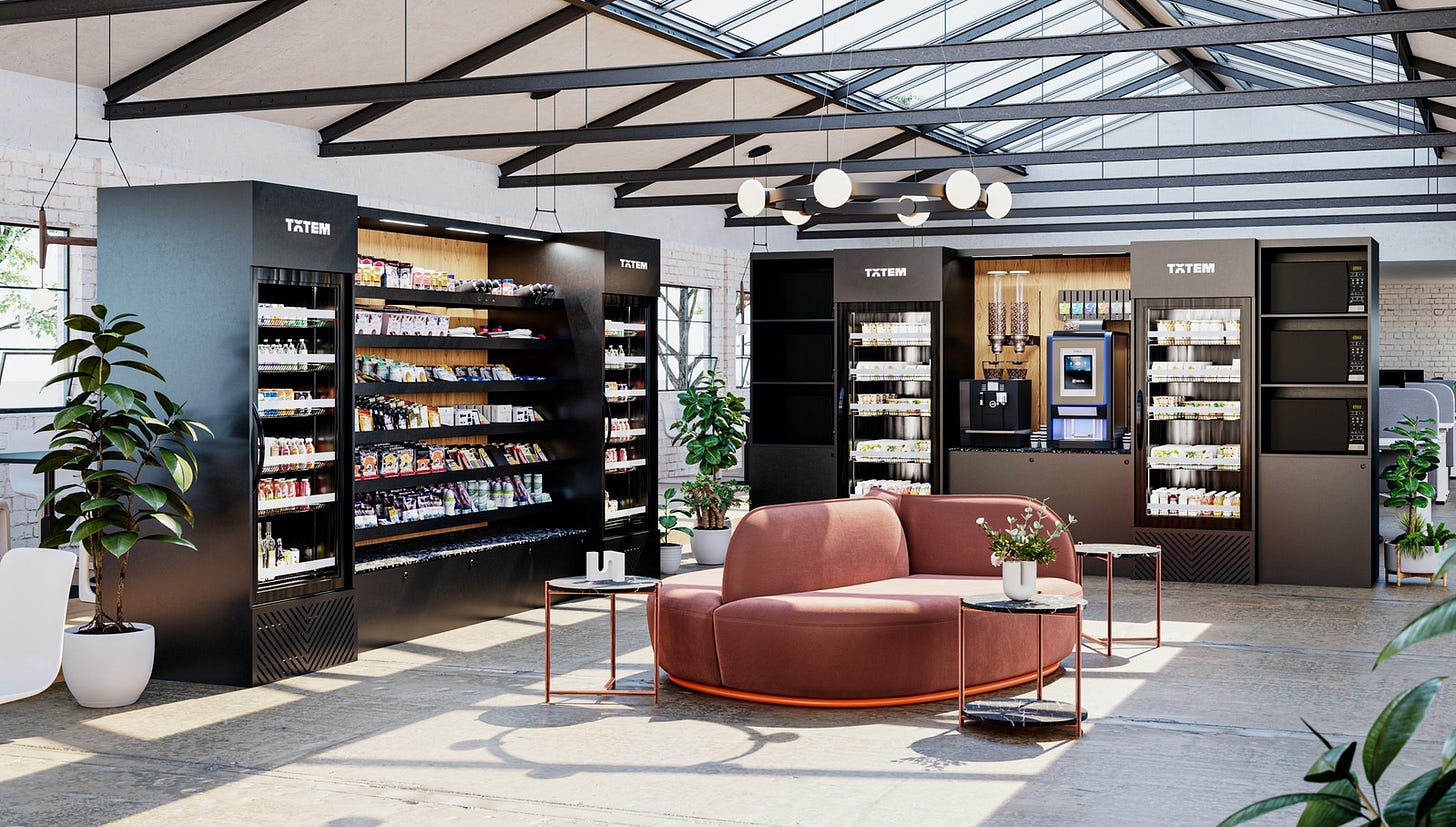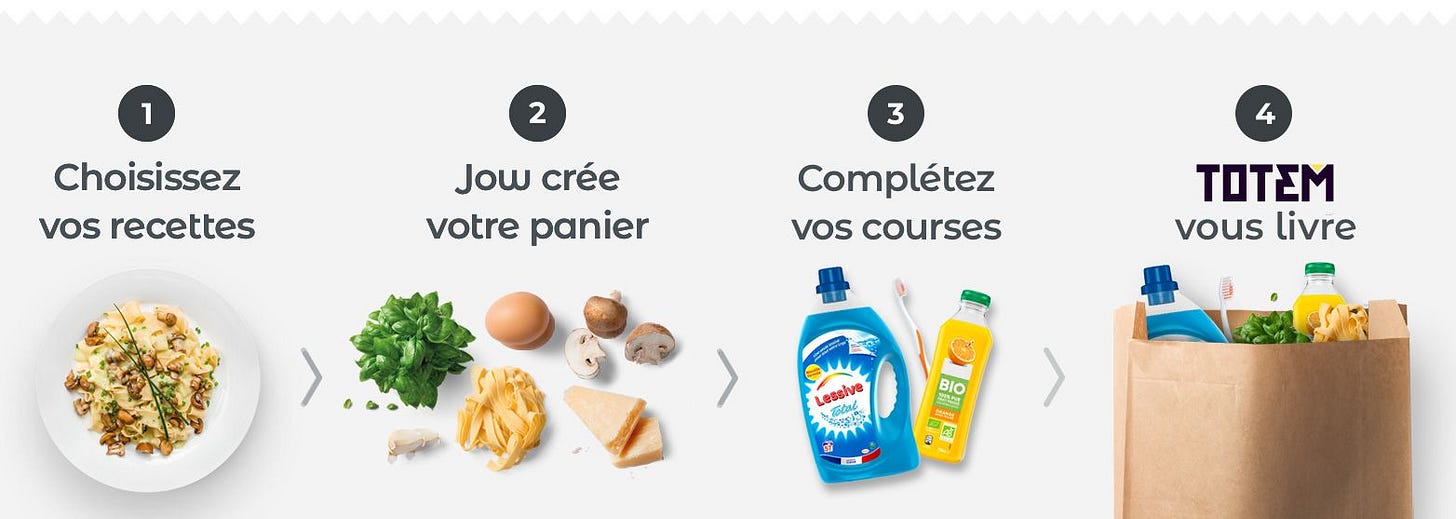Hi, it’s Alexandre from Eurazeo (ex. Idinvest). I’m investing in seed & series A consumer and consumer enablers startups all over Europe. Overlooked is a weekly newsletter about venture capital and underrated consumer trends. Today, I’m sharing the key highlights from our webinar session on the future of grocery.
Earlier this month, we had the pleasure of organizing a webinar to discuss the future of grocery with 3 members of the food industry: Elodie who heads digital transformation at Carrefour (a French multinational retailer), Rafaël, the founder and CEO at Totem (provide offices with stores as a service) and Jacques who is the founder and CEO at Jow (a mobile app for recipe-based grocery shopping). In this post, we will share our main learnings from the webinar. You can rewatch the full webinar here (in French with English subtitles).
Food is now digital, and there's no turning back for traditional grocery
The successive lockdowns due to Covid19 encouraged consumers to order food from home (either groceries or prepared meals). Service apps like Deliveroo, UberEats but also traditional actors, restaurants and retailers like Carrefour have partnered to create new online services that are now completely entranched in consumers' habits.
At first, Carrefour wondered if this online experience was just a fad, prompted by lockdown. Indeed, up until 2020 the food ecommerce was lagging behind non-food ecommerce such as apparel or electronics. In some countries, penetration rates are high (e.g. the UK), with traditional players like Tesco ahead in digitalizing their services. In France, a hybrid form of ecommerce was already in place with the drive formula (you order online and then pick up your bags from the shop some hours later). But overall, most of the grocery experience still happened in stores.
Post lockdown, there is no turning back for consumers. People are now used to ordering online and receiving their groceries at home. What is interesting for Carrefour is that the digital channel has not become a substitute for the offline grocery shopping: the two experiences complement each other. They have implemented digital contact points which happen before the offline grocery experience such as a reading the digital catalogue, looking a loyalty points balance on the Carrefour app. The two add up to improve customer loyalty for a brand overall.
Another interesting trend deriving from Covid for an actor such as Carrefour, was the adoption of ecommerce and digital practices at the company level, across all teams and all managers. This really was a trigger for both digital transformation and cultural transformation. Anyone working at Carrefour now recognizes that digital channels are essential to the very life of a store - even the smallest ones are "ecommerce ready" to play their part as ecommerce operators in the logistic value chain.
The grocery value chain is highly fragmented and new players operate on a variety of segments: restaurant delivery (Deliveroo), multi-product delivery (Glovo), grocery personal shopper (Instacart), and instant delivery shopping (GoPuff or Gorillas). Such actors can be both competitors and partners for traditional retailers. Faced with such disruption, what is most important for Carrefour is to play the game and learn from this innovation (Elodie was actually the first to sign a partnership with UberEats in France). This is also a catalyst for innovation: Carrefour has launched a service in Romania called Bringo, which is both a personal shopper and a marketplace integrating with other brands, including some of their competitors. Another source of digital innovation comes from partnerships with startups. On this, Carrefour is very open and Elodie has a team dedicated to exploring partnerships with them - this has been the case with Jow for example.
In the weeks following our webinar, Carrefour announced a minority investment into Cajoo which is the French contender in the instant delivery category - which is another great proof point of their willingness to stay at the forefront of digital innovations.
Re-inventing the consumer experience of grocery shopping
Jow is a personal shopper which helps consumers prepare their grocery basket based on suggested recipes. Orders are sent to partners and retailers who are onboarded on the platform, such as Carrefour and most retailers in France. Jow is on a mission to change radically the way we do our grocery shopping.
First, what differentiates online grocery shopping from other ecommerce experiences is the basket size and frequency. The average basket contains 25 to 35 items, and consumers will order every week. Even during big festivities like Black Friday, it's very rare for consumers to have baskets with more than 10 items. Up until now, egrocery was mostly built by translating the offline experience to an online one. As a consequence, you have to go and look for products one by one over flat catalogues, drag and drop products into your basket and repeat this again and again for each product, then for each basket, every week. Filling your shopping cart can take ages.
Another pain point is in our every day experience: we all know this situation when the fridge is full but we still ask ourselves: what shall we eat for dinner? and we end up having bought products that we never eat and go directly from the fridge to the bin, because we didn't give enough thought when filling our basket the previous week-end and our fridge is all but inspiring.
Based on the idea of shoppable content, Jow is a 100% recommended interface where you buy recipes and automatically constitute your basket of ingredients: not one by one product, but 5, 6 or 7 products at the same time, so it goes much faster. For the staples part of the basket, the equation is different: consumers don't need inspiration but automation. So Jow pre-builds consumers lists of shampoo, detergents... based on their purchasing data and habits. Jow is one of the very few shoppable content platforms that have proven their efficiency in an industrial way.
Bringing the point-of-sale to the consumer
In one way or another, new grocery players are all bringing the grocery basket to the consumer's home, first they were doing it in 24 hours, then 1 hour, now 15 minutes- and tomorrow 0? This service was helpful for people who were stuck at home during lockdown, but by definition, it removes another layer of social interaction. In our parents and grand-parents' generation, going to the grocery store was a social experience.
Totem is recreating this social experience with what they call "P-commerce" for Proximity commerce, using technology to bring the point of sale to where people are most of the day: the office, hotels, co-living spaces... Totem provides an assortment of goods that can be used immediately, whether it’s food (a quick breakfast, an energy sport bar after an exercise session); but also a pair of tights, a lighter, a battery charger, detergent for the evening laundry... all these small purchases that we forget about or that come in handy in case of emergency. Totem removes many mental burdens on the daily lives of employees and has a much more efficient model compared to other food delivery players (milkman model in which several offices are delivered and individual consumption needed are gathered at the office level).
Totem's model isn't as asset-light as most new entrants in egrocery, but this is also a barrier to entry for them. They have their own warehouse in the north of Paris, from where they operate daily deliveries, on optimized routes. Once consumers are used to this easy access, they tend to rely on it often, particularly for primary needs like coffee when the cost-advantage of benchmarking around the corner is limited. With this model, it is strategic for Totem to get a foothold in one floor of their corporate customers, then gradually expand to other floors. For this, they have to invest heavily before they generate scale profitability.
Building partnerships between startups: the Jow x Totem experience
During the 1st lockdown in March 2020, Jow and Totem decided to collaborate to solve business issues they encountered. In a single day, Totem lost all its revenues because all business offices closed. At the same time, Jow's customers were unable to process their orders because traditional retailers were overwhelmed. Totem wanted to test B2C as a distribution channel. Jow wanted to add another source of products to reduce their dependency to traditional retailers. In just over one week, the whole process was set up. Totem connected its inventory and its backend within Jow's frontend as if it was another retailer.
As Jacques pointed out, startups rarely do partner together to deliver added value, which is a pity. Considering their value proposition, their shared food DNA and their agility, the partnership between Jow and Totem proved to be highly valuable. Not only for customers and from an economic standpoint, but also in terms of learning curve for both startups.
Jow confirmed the strength of its recommendation engine. In this experience both companies had to set up an assortment of 700 SKUs, which is nothing compared to supermarkets which have between 15,000 and 20,000 references. Despite this limitation, Jow realised they could still provide the same value proposition to consumers. As Jow is recommendation-driven and is not a flat-catalogue of product, its front-end will adapt to the logistical and inventory constraints of its partners. End consumers making orders on Jow powered by Totem were able to order their usual favorite recipes and could not see that the assortment was extremely limited.
On Totem's side, they realised that even though they were designed as B2B, they had the agility to adapt to any front-end (either B2B or B2C) as well as to handle fresh products in their operations. Totem used these learnings to expand its offering from free food for employees (coffee, fruits) to micro-stores with (i) a broader range of products (including fresh ones) and (ii) a consumer-facing mobile app specifically designed for employees.
The value of data and its relationships with CPGs
Playing with all these new actors and innovating by themselves was a source of learning for Carrefour. They learnt a lot about how customers adopt a platform like UberEats, what they buy and don't, at what time... The capacity to collect such data has radically changed the conversations retailers have with brands. Before, 90% of their conversations were about stores and offline activity - it’s the opposite today. CPGs themselves invest a lot in data analytics and digital marketing. That's why Carrefour launched a new offer called Carrefour Links, a new way to provide them with data about their customers, in a self-service mode, to understand their ROI, and convert them to new assets at Carrefour.
Interestingly, Jow's founding team doesn't come from the food/ retailer industry, but from the media world. Jow is an app that has impressive engagement metrics: it is not used just once a week to constitute a grocery basket, but every day: when you place your order, then when you're looking up for the recipe of the day to cook. And since 30% of users do their shopping at several retailers, Jow is able to pile up lots of data, permanently connected to all retailers, having a transversal view on inventories and pricing strategies. But Jow also has deep intelligence on households. As a retailer, you are blind to what happens in the household, you can only infer from their basket what happens in reality (for example, if you start buying diapers, you might have a new-born at home). Jow actualy knows how many people were at the table, how many children, whether they used a Thermomix or not, which product they're allergic to... this data is valuable for FMCG brands, appliance brands, and of course retailers.
On flat catalogues, it is very hard to influence the purchasing decision of consumers, except with pricey discounts that lead to vicious circles both for the brand and the retailer. On the contrary, Jow can place a product directly into a consumer basket. For the anecdote, one of the best selling products on Jow was udon noodles - something most consumers would have ignored in an hypermarket alley. But with an appetizing recipe, consumers have realized that cooking udon noodles was as simple as spaghetti and could brag about their cooking skills. Jow also helps CPGs to educate on broader product usages: for example Danone could teach consumers that their yogurts were not only good for deserts, but also to cook Lebanese-style turkey stir-fry with a yogurt sauce.
Totem too can collect valuable consumption data to provide market intel to brands: A/B testing on packaging for example, or assessing the right pricing.
Thanks to Julia (🦒) for the feedback and Sophie for collaborating on this one! Thanks for reading! See you next week for another issue! 👋






